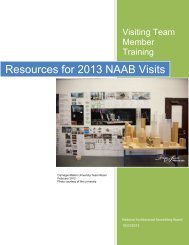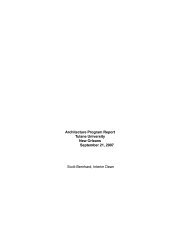NAAB Architecture Program Report (APR) 2013 - Tulane School of ...
NAAB Architecture Program Report (APR) 2013 - Tulane School of ...
NAAB Architecture Program Report (APR) 2013 - Tulane School of ...
Create successful ePaper yourself
Turn your PDF publications into a flip-book with our unique Google optimized e-Paper software.
<strong>Tulane</strong> University<strong>Architecture</strong> <strong>Program</strong> <strong>Report</strong>September <strong>2013</strong>innovation and to develop the next generation <strong>of</strong> community-minded citizens and leaders.Mission <strong>of</strong> the <strong>Tulane</strong> <strong>School</strong> <strong>of</strong> <strong>Architecture</strong>The mission <strong>of</strong> the <strong>Tulane</strong> <strong>School</strong> <strong>of</strong> <strong>Architecture</strong> is to prepare students for leadership positions in thedesign pr<strong>of</strong>essions and in their communities. This school aspires to provide the highest qualitypr<strong>of</strong>essional education in architecture, to develop and conserve knowledge, and to promote excellenceand innovation in architecture, landscape urbanism, preservation, and urban and environmental designand development. The <strong>School</strong> aspires to reach many students within and beyond Richardson MemorialHall through undergraduate minors in <strong>Architecture</strong>, Certificate in Preservation, and through the minor inSocial Innovation and Social Entrepreneurship. The <strong>School</strong> recognizes the centrality <strong>of</strong> design thinkingas a process <strong>of</strong> synthesis that incorporates history, theory, technology, economics, behavior, andculture. The <strong>School</strong> supports diversity and meaningful engagement with urban and community issues,while embracing the creative potential and imperative <strong>of</strong> sustainable design. As a framework, threeprimary concepts and values are infused in the academic mission:• Educating students in the abiding cultural and social roles <strong>of</strong> architecture, preservation, andreal estate development by providing a well-rounded, humanities-based education withdiscipline-specific coursework;• Preparing future pr<strong>of</strong>essionals through continually assessed and updated coursework indesign, building technology, and pr<strong>of</strong>essional concerns with an emphasis on critical thinking;• Instilling a sense <strong>of</strong> responsibility and ethical conduct through civic engagement.History <strong>of</strong> the <strong>Tulane</strong> <strong>School</strong> <strong>of</strong> <strong>Architecture</strong>The first courses in architecture at <strong>Tulane</strong> University leading to a degree in architectural engineeringwere <strong>of</strong>fered in 1894 under the direction <strong>of</strong> Pr<strong>of</strong>essor William Woodward. An article published in 1907noted, “the geographical location <strong>of</strong> the city <strong>of</strong> New Orleans, its cosmopolitan character, and the ageand variety <strong>of</strong> its unique building types, make it a fit place in which to develop a school <strong>of</strong> architecturewhich would be suited to its environment, maintain a reasonableness <strong>of</strong> planning and construction, andbe recognized as appropriate to the climatic conditions.” Accordingly, a full four-year pr<strong>of</strong>essionalcurriculum in architecture leading to a bachelor’s degree, was established in the College <strong>of</strong> Technology(Engineering) in the academic year 1907-1908. At that time Samuel S. Labouisse, Moise H. Goldstein,and Allison Owen joined the staff. In 1912, Pr<strong>of</strong>essor Nathaniel Cortlandt Curtis was appointed head <strong>of</strong>the newly independent <strong>Architecture</strong> Department; he was succeeded by Pr<strong>of</strong>essor John HerndonThomson and Pr<strong>of</strong>essor Buford L. Pickens in 1946.At the conclusion <strong>of</strong> the Second World War, the faculty and enrollment increased to accommodatereturning veterans, and the school continued to grow throughout the next two decades. John EkinDinwiddie was appointed dean <strong>of</strong> the <strong>School</strong> <strong>of</strong> <strong>Architecture</strong> in 1953; he was succeeded by Pr<strong>of</strong>essorJohn William Lawrence in 1960. In 1971, the <strong>School</strong> <strong>of</strong> <strong>Architecture</strong> moved into its present facility,Richardson Memorial Hall, and experienced another increase in enrollment that continued throughoutthe seventies. Pr<strong>of</strong>essor William Kay Turner became the dean in 1972, and in 1975 a small graduateprogram was initiated, <strong>of</strong>fering a course <strong>of</strong> study leading to the Master <strong>of</strong> <strong>Architecture</strong> II as a postpr<strong>of</strong>essionaldegree. Ronald Coulter Filson became dean in 1980.In the summer <strong>of</strong> 1990 the <strong>School</strong> began a program <strong>of</strong>fering a Master <strong>of</strong> <strong>Architecture</strong> as a firstpr<strong>of</strong>essional degree for students with undergraduate degrees in other disciplines. Donna V. Robertsonsucceeded Dean Filson in 1992. <strong>Tulane</strong> faculty member Donald F. Gatzke was appointed Dean <strong>of</strong> the<strong>School</strong> <strong>of</strong> <strong>Architecture</strong> in 1997, just as the <strong>School</strong> initiated its Master <strong>of</strong> Preservation Studies program.Also in 1997, a supplemental Certificate in Preservation Studies was <strong>of</strong>fered to undergraduates for thefirst time. In 2003, the <strong>School</strong> eliminated the 5 year Bachelor <strong>of</strong> <strong>Architecture</strong> degree, replacing it with a5 year Master <strong>of</strong> <strong>Architecture</strong> as the pr<strong>of</strong>essional degree. Former <strong>Architecture</strong> magazine editor-in-chiefReed Krol<strong>of</strong>f became dean in October 2004. In 2005 the <strong>School</strong> initiated the <strong>Tulane</strong> City Center, itsurban research and outreach program, as well as URBANbuild, which helps rehabilitate neighborhoodsthrough urban design and the construction <strong>of</strong> student-designed and built housing prototypes.2














